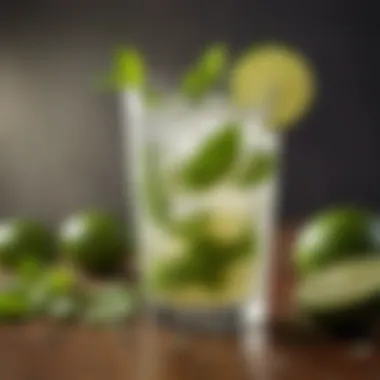Delightful Fruity Alcoholic Drinks to Order


Intro
Fruity alcoholic drinks present an inviting realm of flavors that can elevate any gathering. They bring together the zest of fresh fruits with the warmth of alcohol, creating delightful concoctions for various occasions. Whether at an upscale bar or a backyard barbecue, understanding the variety of fruity drinks available can enhance the experience. This guide aims to illuminate the path to selecting the perfect fruity beverage, detailing the characteristics that make these drinks appealing.
From cocktails rich in tropical fruits to wines that highlight berry undertones, the range is vast. Each drink has its unique profile, influenced by the ingredients and preparation methods. This article will cover notable options, exploring their flavors, appropriate pairings, and the artistry behind their creation. Our audience includes both casual drinkers looking for recommendations and connoisseurs seeking new experiences.
As you delve into the world of these vibrant drinks, remember that good choices stem from understanding what each drink offers. The selection of fruity alcoholic beverages is not just about taste but also about the ambience they create. Each sip can reflect the occasion it represents, making it essential to be well-informed. With this guide, you will be prepared to make decisions that are suited to your preferences and surroundings.
"A well-crafted fruity drink does not only quench thirst, it elevates the moment."
Let us now explore some specific recipes that demonstrate this fusion of fruit and alcohol, highlighting their unique qualities.
Preamble to Fruity Alcoholic Drinks
Fruity alcoholic drinks offer a unique intersection of flavor and refreshment, making them a popular choice at bars, restaurants, and social gatherings. The blend of natural fruit elements with spirits not only enhances the taste but also beautifies the presentation. Understanding the allure behind these beverages can significantly enhance one’s drinking experience.
Understanding Fruity Flavors
Fruity flavors play a pivotal role in the appeal of alcoholic drinks. They add complexity and brightness, often contrasting with bitter or strong alcohol notes. Natural fruits, such as strawberries, limes, and pineapples, act as both flavor enhancers and visual delights. Mixing various fruits can produce a sophisticated balance. This balance is crucial when creating refreshing cocktails or fruity alternatives. Different fruits bring their unique tastes. Citrus fruits offer acidity, while berries contribute sweetness. Recognizing these subtleties can aid in selecting drinks that best suit personal preferences.
When preparing cocktails, the method of incorporating these fruits can influence the overall taste. Muddling fresh fruits releases their juices, while infusing spirits with dried fruits creates a different tasting experience. The possibilities are endless, making fruity cocktails versatile and appealing to many palates.
The Appeal of Fruit in Cocktails
The popularity of fruit in cocktails lies in both taste and aesthetic qualities. Visually, colorful fruits enhance the overall appeal of a drink. A well-presented cocktail, adorned with fresh fruit slices or vibrant fruit purees, is more inviting. This visual stimulation often influences purchasing decisions.
Moreover, fruity alcoholic drinks tend to be lighter, appealing to those who prefer refreshing tastes over heavier spirits. They are excellent options during warmer seasons or casual outings. The incorporation of fruits also allows for creating drinks that can cater to various taste profiles. From sweet to tart, or even spicy, fruit provides a versatile base for mixologists.
When considering the benefits of fruity cocktails, it’s important to note their tendency to mask the alcoholic content. This masking can lead to consuming drinks more quickly than intended. Therefore, being mindful of one's intake is essential, even if the drink tastes delightful. Overall, the interplay of flavor, appearance, and enjoyment makes fruity alcoholic drinks a staple for many.
Classic Fruity Cocktails
Classic fruity cocktails hold a significant place in the realm of mixed beverages. They not only showcase the delightful combination of fruit flavors and spirits but also reflect the rich history of cocktail culture. Many people enjoy these drinks for their refreshing taste, vibrant colors, and appeal to a wide range of palates. These cocktails can elevate any occasion, be it a casual gathering or a formal event. Understanding classic fruity cocktails provides insight into the artistry behind mixology and enhances the overall drinking experience.
Pina Colada
Ingredients and Preparation
The Pina Colada is a quintessential tropical cocktail, often associated with seaside retreats. This drink typically consists of rum, coconut cream, and pineapple juice, blended with ice to create a smooth and frothy texture. The preparation of a Pina Colada is straightforward, making it a popular choice among bartenders and home enthusiasts alike. The frosty consistency is one of the drink's most appealing characteristics, as it offers a refreshing escape from the heat while delivering a delightful sweetness.
When preparing this cocktail, using fresh ingredients can significantly enhance its flavor profile. Utilizing ripe pineapples and quality rum ensures that each sip is rich and satisfying. A disadvantage, however, might be that the drink can be overly sweet for some tastes, which is something to consider based on individual preferences.
Tasting Notes
The tasting notes of a Pina Colada are marked by the creamy, tropical sensations of coconut and pineapple. When sampled, it presents a balanced blend of sweetness and acidity, without overshadowing the rum's subtle spices. This harmonious interplay makes it a beneficial choice for newcomers to fruity cocktails, as it is approachable yet flavorful.
An interesting aspect of the Pina Colada is its versatility in flavor; some recipes integrate additional fruit or flavorings, such as mango or passion fruit, to provide a unique twist. The challenge with these variations can be finding the right balance to maintain the signature taste.
Variations to Consider
While the traditional Pina Colada is cherished for its classic flavor, numerous variations exist to suit different tastes. Options like the frozen Pina Colada or fruit-based adaptations, such as a Mango Pina Colada, can introduce new elements while preserving the drink's essence. These variations can cater to diverse palates, making the drink accessible to wider audiences.
Experimenting with variations not only enhances creativity but also allows for personalization in preparation. However, one must be cautious not to stray too far from the original flavor that defines the cocktail. Success largely relies on maintaining the drink's fundamental profile even when introducing new flavors.
Mojito


Key Ingredients
The Mojito is another classic fruity cocktail that combines the refreshing qualities of mint and lime with the crispness of rum. Its key ingredients include fresh mint leaves, lime juice, sugar, soda water, and white rum. The mint is essential, adding a cooling sensation that complements the tartness of the lime.
The balance of these ingredients is crucial for achieving the right flavor. It is important to muddle the mint gently; over-muddling can result in a bitterness that overshadows the drink's signature freshness. This complexity is what makes the Mojito not only popular but favorably memorable in the cocktail repertoire.
How to Perfect Your Mojito
Perfecting a Mojito involves more than just following a recipe. One must focus on technique, ensuring each ingredient is integrated properly. Choosing high-quality rum and fresh ingredients elevates the drink significantly. Muddling the mint properly enhances flavor without creating bitterness. The ratio of ingredients also plays a substantial role, with the right amount of sugar balancing the lime’s acidity.
Additionally, carbonation from soda water should be added last to maintain the cocktail's effervescence. A common mistake is to shake the mixture, which disrupts the delicate balance of flavors. Instead, a gentle stir after mixing can keep the Mojito's refreshing qualities intact, allowing each sip to refresh without overwhelming sweetness.
Serving Suggestions
When serving a Mojito, presentation can enhance the experience. Using a tall glass allows for a visually appealing display of mint leaves and lime wedges. A simple garnish, often a sprig of mint, can add a touch of color and a hint of freshness as well.
Pairing Mojitos with light appetizers or tapas makes for a delightful experience. Their acidity and fresh flavors complement dishes like grilled seafood or ceviche perfectly. However, one should be mindful of the serving size; too many calories from sugary mixers can detract from an otherwise balanced cocktail experience.
Daiquiri
Classic vs. Fruity Variants
The Daiquiri is among the most celebrated classic cocktails, renowned for its simplicity and versatility. Traditionally, it consists of just rum, sugar, and lime, offering a clean and crisp texture. In contrast, fruity variants incorporate various fruits like strawberries or peaches, adding sweetness and complexity to the mix. These adaptations can draw more attention from those who prefer a sweeter profile, making the drink appealing for a broader audience.
However, while fruity variants may enhance the cocktail's allure, some purists argue that such modifications stray from the drink's origins. Finding the right balance between maintaining the classic essence while exploring diverse flavors is essential to enjoying this cocktail.
Essential Ingredients
Essential ingredients for a true Daiquiri include white rum, fresh lime juice, and sugar. The quality of these components significantly impacts the final product. High-quality rum can provide depth, while fresh lime juice ensures a zesty foundation that is vital to the cocktail's appeal. Weak or synthetic flavors can result in a subpar drinking experience.
Using simple syrup instead of granulated sugar can also enhance smoothness and ensure all ingredients blend seamlessly. This tends to be a better option for maintaining a clean flavor profile in both classic and fruity versions of the Daiquiri.
Recommended Brands of Rum
To create a quality Daiquiri, opting for reputable rum brands is crucial. Brands such as Bacardi, Mount Gay, and Flor de Caña are popular choices among enthusiasts. Each type offers its signature characteristics that can contribute to different flavor profiles.
While opting for premium brands can elevate the drink, it is essential to consider personal preferences and budget. A well-crafted Daiquiri, regardless of the rum choice, can highlight the balance of flavors that define this cocktail, appealing to anyone looking for refreshing fruity drinks.
Exotic Fruity Drink Options
Exotic fruity drink options add a unique twist to the typical cocktail selection. These drinks often include diverse ingredients which not only enhance the flavor but also provide a cultural experience. Exploring exotic drinks allows for a broader understanding of how different fruits and ingredients can complement alcohol. They appeal to adventurous drinkers looking to try something new and offer a sensory journey to unfamiliar tastes.
Mai Tai
Origin and History
The Mai Tai's origin is somewhat debated, but it is widely believed to have been created in the 1940s in California. The drink's name comes from the Tahitian phrase meaning "good". This cocktail quickly gained popularity and is now a staple in tiki culture. Its blend of flavors brings a taste of the tropics, which can evoke an escape from the daily routine. Understanding its history enriches the drinking experience and gives context to its growing fame.
Mixing Instructions
Mixing a Mai Tai is straightforward yet requires attention to detail to achieve the ideal balance. The classic recipe calls for a mix of rum, lime juice, orgeat syrup, and orange liqueur. Shake the ingredients with ice and then strain them into a glass filled with ice. A float of dark rum on top enhances the visual appeal and complexity of the drink. Following traditional mixing techniques ensures a consistent flavor profile, making it a reliable choice for both novice and experienced bartenders.
Flavor Profiles
The Mai Tai is characterized by its fruity and nutty flavors, providing a refreshing yet complex taste. The sweetness of the orgeat is balanced by the tartness of lime, while the rum adds depth with its own unique notes. This cocktail's versatility allows for experimentation with different rums and additional fruits, like pineapple or orange. Such flexibility makes it appealing in various settings, accommodating different palates and preferences.
Caipirinha


Brazilian Roots
The Caipirinha hails from Brazil and is made with cachaça, sugar, and lime. Its simplicity is one of its key characteristics and contributes to its popularity. Originated as a drink of the people, it offers an authentic taste of Brazilian culture. Understanding these roots helps appreciate the drink and makes it an interesting conversation piece among enjoyers. It brings a bit of Brazil to any gathering.
Key Ingredients
The key ingredients of a Caipirinha include cachaça, fresh limes, and sugar. Cachaça is a spirit made from fermented sugarcane juice, giving the drink its distinctive flavor. The use of fresh lime adds essential acidity that balances the sweetness. This combination creates a refreshing experience, especially in warm climates, making the Caipirinha a favored choice for summer gatherings.
Serving Tips
Serving a Caipirinha requires a simple yet effective technique. First, muddle the lime and sugar at the bottom of the glass to release the juice. Then, add ice and pour the cachaça over the top. It can be served in a rocks glass or short glass. Providing a straw allows for easy sipping and blending of flavors. Such serving tips enhance the drink's presentation and overall drinking experience, attracting those new to this refreshing cocktail.
Contemporary Fruity Cocktails
Contemporary fruity cocktails represent a modern evolution of traditional drinks, highlighting the trend towards customization and creativity in mixology. These drinks not only emphasize fruit flavors but also allow for unique and personal variations. They cater to diverse palates and dietary needs, making them an attractive option for both casual settings and sophisticated gatherings. The incorporation of fresh fruits and innovative ingredients enables both bartenders and home enthusiasts to experiment, offering a refreshing twist on fruity beverages.
Fruit-Infused Gin and Tonic
Choosing Your Gin
Choosing your gin is a critical step in crafting a fruit-infused gin and tonic. The type of gin you select directly impacts the overall flavor profile of the drink. Look for gins that feature botanicals in their production; these can enhance the fruity flavors you intend to add. For example, a floral gin can complement fruits like strawberries or elderflower. In contrast, a more juniper-forward gin pairs better with citrus fruits.
The unique feature of gin lies in its versatility. Using craft brands may provide distinctive flavors that mass-produced options do not. However, this can also mean experimenting with various brands to find the perfect match for your taste.
Best Fruits to Use
When it comes to the best fruits to use in a gin and tonic, seasonal produce should be prioritized. Fresh ingredients not only provide vibrant flavor but also contribute to the visual appeal of the drink. Citrus fruits like lime, lemon, and grapefruit enhance the refreshing quality of the gin. Delicate fruits such as raspberries and blueberries offer a softer, nuanced sweetness.
One main advantage of using fresh fruits is their ability to change flavors based on ripeness and season. However, some fruits can overpower the delicate notes of specific gins if not balanced correctly. Thus, experimenting with fruit combinations is essential to achieving the right flavor harmony.
Garnishing Options
Garnishing your fruit-infused gin and tonic elevates not just the visual aspect, but also the overall tasting experience. Common choices include herb sprigs, such as rosemary or mint, which add a fresh aromatic element. Cucumber slices can add a crisp contrast, while edible flowers can create an elegant touch.
The key characteristic of garnishing is that it should enhance, not detract from the main ingredients. A thoughtful garnish will encourage engagement with the drink through scent and taste. Yet, using too elaborate garnishes might overwhelm the drink’s flavor balance, so simplicity often works better.
Fruity Sangria
Traditional vs. Modern Recipes
The debate between traditional and modern sangria recipes highlights the evolution of this timeless drink. Traditional sangria is often rooted in Spanish customs, featuring red wine, chopped fruits, and little more than some brandy or orange liqueur. Modern iterations may incorporate white wines, sparkling wines, or even non-alcoholic versions, vastly expanding the flavor spectrum.
A unique feature of modern sangria is its inclusion of various spirits and flavorings, creating a more diverse tasting experience. This flexibility allows hosts to create their own unique concoctions, making sangria a popular choice for gatherings. However, sticking too closely to tradition can sometimes yield a more balanced and authentic flavor profile.
Pairing with Foods
Pairing fruity Sangria with food enhances the overall dining experience. Its sweet and refreshing nature makes it ideally suited to lighter fare, such as seafood dishes, tapas, or salads. The acidity of the wine in sangria can cut through rich flavors, providing balance on the palate.
The advantage of these pairings is that they encourage exploration of contrasting flavors. Still, not all foods complement sangria well; heavy or overly spicy dishes may clash with its fruitiness. Therefore, careful consideration is crucial to achieve harmony.
Creating a Pitcher for Groups
Creating a pitcher of fruity sangria for groups is both practical and enjoyable. Sangria is inherently designed for sharing, making it a go-to drink for parties and gatherings. A pitcher allows for easy preparation and serving, enabling hosts to focus on their guests rather than mixing individual drinks.
The key aspect of a group sangria is its scalability. Recipes can be easily adjusted according to the number of guests. This convenience makes sangria an excellent choice for celebrations. However, if not prepared in advance, flavors may not have time to meld properly. It is advisable to create the mix a few hours before serving for the optimal taste.


Non-Alcoholic Alternatives
Fruity alcoholic drinks offer an array of flavors and styles, appealing to numerous tastes. However, there is an equally impressive world of non-alcoholic options that deserve attention. Non-alcoholic alternatives provide a refreshing choice for those who may abstain from alcohol for personal, health, or lifestyle reasons. These drinks maintain the spirit of fruity cocktails without the intoxicating effects, and they cater to a growing demand among consumers seeking delicious zero-proof beverages.
The importance of non-alcoholic fruity drinks in this article lies primarily in their inclusivity. More people are turning to non-alcoholic options without sacrificing flavor. In many social situations or gatherings, non-drinkers may feel left out when only alcoholic beverages are offered. Thus, showcasing non-alcoholic fruity drinks ensures everyone can enjoy delightful and flavorful options. These drinks can mimic the complexity of their alcoholic counterparts, making them appealing to both non-drinkers and those who want to moderate their intake.
Mocktail Versions of Fruity Drinks
Popular Mocktail Recipes
Mocktail recipes are significant because they provide a way to enjoy the fruity flavors commonly found in cocktails without the effects of alcohol. Popular mocktail recipes often feature vibrant combinations of fruits and mixers, creating eye-catching and refreshing beverages. For instance, a virgin mojito made with mint, lime, and soda water can mimic the intense experience of the classic version. These recipes offer enjoyment derived from taste rather than intoxication.
One key feature of popular mocktail recipes is their versatility. You can customize them based on preferences or seasonal ingredient availability. Another aspect is how they maintain balance, ensuring the drink is flavorful yet not overwhelming. However, some may find certain mocktails too sweet, depending on ingredient choices. It is essential to adjust elements based on personal preference while crafting these beverages.
Ingredients Overview
Ingredients play a crucial role in the creation of enticing mocktail versions of fruity drinks. Quality ingredients can elevate the overall experience, making it enjoyable and memorable. Common ingredients in mocktails often include fresh fruits, herbs, and premium mixers like tonic water or flavored sodas. This assortment enables variety and complexity, enhancing the flavors without alcohol.
A notable characteristic of the ingredient overview is the emphasis on freshness. Freshly squeezed fruit juices will generally yield a more vibrant taste compared to packaged alternatives. Moreover, using seasonal fruits can introduce exciting and unusual flavors into mocktails. An advantage of choosing mocktail ingredients is the straightforward nature of preparation, making it easy for anyone to mix them up at home.
Flavor Balance Techniques
Flavor balance techniques are essential when crafting non-alcoholic fruity drinks, as they ensure the final mix is both enjoyable and harmonious. Achieving balance may involve adjusting sweetness, acidity, and bitterness levels. A well-balanced mocktail wins over drinkers by making every sip pleasant.
One prominent method for balancing flavors is including citrus elements. Citrus fruits like lime, lemon, or grapefruit can introduce acidity which cuts through sweetness, creating a more complex taste profile. Moreover, using fresh herbs can offer additional depth, enhancing the overall experience of drinking the mocktail. However, oversweetening or neglecting to consider acidity can lead to an unbalanced drink, leading to dissatisfaction.
Using flavor balance techniques not only enhances enjoyment but also provides an educational aspect, encouraging the exploration of fruit pairing possibilities. Non-alcoholic drinks can be just as intricate as alcoholic ones, attracting both novice and experienced drinkers.
Pairing Fruity Drinks with Food
Pairing fruity drinks with food elevates the overall dining experience. It enhances flavors, balances taste profiles, and can introduce exciting culinary combinations. When selecting fruity cocktails or wines, the accompanying dishes play a critical role. Knowing how to pair drinks with food can transform a simple meal into a memorable event.
Best Food Pairings for Fruity Cocktails
Cuisine Suggestions
Different cuisines offer unique flavors that can complement fruity drinks. For instance, the freshness of Mediterranean dishes like grilled shrimp or tabbouleh enhances fruit-forward cocktails like a Mojito or Fruit-Infused Gin and Tonic. The zesty components of these meals interact nicely with mint and citrus notes in the drinks.
Moreover, Asian cuisine, including dishes like sushi or Thai curry, pairs well with fruity cocktails. The sweetness and acidity in drinks such as Sangria balance the spices and freshness of the food. The cherry or pineapple notes in a well-crafted drink can bring out subtle flavors in these dishes. Consider the overall palate when making these picks; lighter, brighter foods often harmonize better with vibrant cocktails.
Essential Flavor Combinations
Understanding flavor profiles is key to effective pairings. Fruity cocktails often feature sweet, tart, or refreshing elements. The sweetness in drinks like Daiquiri can cut through the richness of fried foods, while tart flavors enliven heavier dishes. This dynamic creates a symbiotic relationship between the food and drink.
Furthermore, contrasting flavors can also work wonders. For example, pairing a sweet Mai Tai with spicy jerk chicken creates a delightful tension on the palate. The sweetness balances the heat, resulting in a well-rounded taste experience. It's essential to experiment and find what resonates personally.
"Pairing fruity drinks with food not only enhances flavors but also creates a more enjoyable dining experience."
The End
In the realm of fruity alcoholic drinks, understanding one's choices can significantly enhance the experience. This article has explored various aspects of fruity beverages, shedding light on classic cocktails, contemporary options, and even non-alcoholic alternatives. Key elements such as flavor profiles, ingredient selection, and food pairings have been presented to guide readers in making informed decisions.
Final Thoughts on Choosing Fruity Alcoholic Drinks
Choosing a fruity alcoholic drink goes beyond merely selecting something appealing; it encompasses a blend of personal preference, context, and culinary enjoyment. Consider the occasion when picking your drink. For a casual outing, a refreshing mojito might suffice, whereas a sophisticated gathering could call for a complex fruit-infused gin and tonic.
"Choosing the right drink can transform a good time into a memorable one."
When you consider the ingredients, opt for quality spirits and fresh fruits. Each ingredient contributes uniqueness to the drink. For instance, the decisions like whether to use fresh lime or bottled lime juice in a cocktail can influence overall taste.
Look for seasonal fruits to elevate the drink's freshness. This can enhance the experience and supports local produce. If pairing with food, align flavors; fruity drinks often complement dishes that include light proteins or spicy themes.
In summary, the world of fruity alcoholic drinks is rich and varied. Mastering the elements involved not only improves your drink-making skills but also elevates your appreciation for the diverse flavors these beverages can offer.















